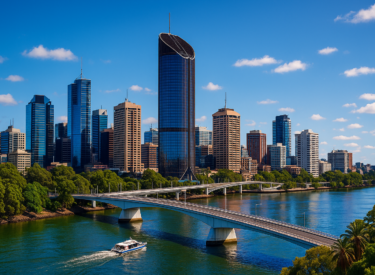
Key takeaways
Since 1966, Australia has shifted from a predominantly Anglo-Celtic, agriculture- and manufacturing-based economy to one of the wealthiest, service-oriented nations globally.
Historically, unemployment has mirrored Australia's economic health and demographic shifts.
Structural demographic factors—such as retiring Baby Boomers, Millennial parenting phases, and smaller Gen Z populations—suggest unemployment will remain low (below 5%) for the next decade.
Labour shortages in healthcare, education, aged care, and tech will persist, offsetting AI-induced job changes.
Despite wealth growth, inequality is widening, shrinking the middle class and increasing hardship among lower-income groups.
Housing affordability and wage stagnation remain significant issues requiring strategic policy responses.
Australia's economy will continue relying on mining, agriculture, international education, and tourism.
The ongoing urbanisation in Asia (especially India, Indonesia, and the Philippines) and growing global food security concerns enhance long-term opportunities for Australia.
Have you ever stopped to think how far Australia has come in the past 60 years?
In 1966, we were a nation of 11 million, fresh off switching from pounds, shillings, and pence to dollars and cents.
That transition was more than monetary.
It symbolised our shift from being a British outpost to finding our own economic and cultural identity.
We were largely Anglo-Celtic, heavily reliant on agriculture and manufacturing, and our cities were smaller, more compact, and very different from the sprawling urban hubs we see today.
Fast forward to today – 2025, and the transformation is profound.
We’ve become one of the wealthiest nations on earth.
Yes, we’re battling a cost-of-living crisis.
But we’re also living longer, better, and in many ways smarter than ever before.
And underneath it all, our success story can be traced through a single, powerful metric: unemployment.
For weekly insights and strategic advice, subscribe to the Demographics Decoded podcast, where we will continue to explore these trends and their implications in greater detail.
Subscribe now on your favourite Podcast player:
A story told through unemployment
In our latest episode of the Demographics Decoded podcast, Simon Kuestenmacher and I took a deep dive into unemployment data stretching back to 1966 – the earliest reliable figures we have.
What emerged was a fascinating portrait of Australia’s transformation, not just economically but socially and demographically.

In the 1960s, Australia had an unemployment rate of just 2%.
That’s not a typo – two per cent.
We were essentially at full employment.
This wasn’t just luck.
There were far fewer people of working age, largely because of the impact of World War II.
And the first wave of baby boomers – born in the late 40s and 50s – was entering the workforce.
Massive families (3.8 children per woman at one point) meant there was a flood of young workers competing for jobs, which helped keep wages low.
That made manufacturing viable.
It was affordable to produce goods locally, and we did so at scale.
Migration also played a strategic role.
Post-war, we welcomed low-skilled workers, many from Mediterranean countries like Greece and Italy, to support our factories, build our suburbs, and pour the foundations, literally, of modern Australia.
From oil shocks to economic overhauls
The early 70s saw unemployment tick up slightly to around 4%, but it wasn’t until the oil shocks of the mid-70s that we saw real cracks emerge.
Global energy instability made manufacturing more expensive, and the global economy began changing faster than our own.
By the early 80s, unemployment had surged to 10%.
Tariff protections were removed, and we opened up to global competition.
This was a period of deep restructuring.
Our economy shifted away from manufacturing towards services, and it wasn’t without pain.
Simon pointed out that this was when Australia had to rethink its economic model.
Deregulation followed, along with labour market reform – all of which caused initial job losses.
It was a tough adjustment, but a necessary one.
The 1990s began with another recession – the infamous “recession we had to have,” as Paul Keating called it.
Unemployment again hovered around 10%.
It was particularly tough in Victoria, where people left in droves.
I remember people joking, “Last one out of Melbourne, turn off the lights.”
Financial institutions collapsed.
Property prices dropped.
Confidence evaporated.
But out of this came a more flexible, competitive economy, one that embraced technology, productivity, and eventually global opportunity.
Productivity, confidence, and the mining boom
By the late 90s, things began to turn around.
Computers were entering the workplace, helping improve productivity.
Gen Xers were now firmly in the workforce, and Australia was regaining its confidence.
The Sydney Olympics symbolised a new era – optimistic, outward-looking, and globalised.
Then came the China boom.
As China urbanised, it couldn’t get enough of our iron ore, coal, and resources.
That boom drove growth, created jobs, and filled government coffers.
Unemployment began a steady downward trend, falling from 11% in 1990 to around 4% by the mid-2000s.
Simon reminded me that this period also reshaped national psychology.
We moved from being tentative and reactive to increasingly confident.
It seemed like, after decades of adjustment, Australia had found its groove.
GFC: a near miss
The Global Financial Crisis between 2007 and 2009 shook the world.
Triggered by bad lending practices in the US housing market, it caused financial chaos globally.
Millions lost their jobs. Banks went bankrupt.
But Australia? We avoided a recession.
Why?
Because China kept buying our resources.
Because we had a strong regulatory system.
And because, even though unemployment jumped from 4% to 6%, it was short-lived.
Simon and I both agree – we grumble about APRA and lending regulations, but during a crisis, it’s these very safeguards that save us.

COVID-19 and the fastest recovery ever
Then came 2020.
The pandemic hit like a freight train.
Unemployment spiked sharply – almost 8% – and there were grim predictions of double digits.
But thanks to swift interventions like JobKeeper, stimulus packages, and temporary regulation changes, we avoided a collapse.
Simon rightly described this as an “outrageous recovery.”
Within two years, unemployment dropped back below 4%.
What baffled economists was how unemployment stayed so low, even as interest rates rose.
Simon had a simple explanation: demographics.
We’re running out of workers.
Boomers are retiring in droves.
Millennials – our biggest generation – are entering the child-rearing phase and stepping back from full-time work.
Gen Z is smaller and not enough to fill the gaps.
So despite rising interest rates, the labour market has remained tight.
Why we won’t see high unemployment again (barring disaster)
Simon made a bold – but I believe accurate – forecast: Australia won’t see 5–6% unemployment again in the next decade.
There are too few workers.
The demand for jobs in healthcare, aged care, education, and technology will outstrip supply.
And while AI will make some roles redundant, it will also enhance productivity and create new roles that we can’t even predict yet.
Even if international shocks occur, we have levers to pull, especially migration.
It’s the tool we’ve used for decades to balance our labour force, and we’ll use it again.

A shrinking middle class and rising inequality
Of course, not all is rosy.
Simon warned of economic hollowing out – more wealth at the top, more hardship at the bottom, and a shrinking middle.
That’s a challenge we’ll have to confront, especially as property becomes less affordable for younger Australians and wages stagnate in certain sectors.
That said, our overall national wealth is still increasing.
The real challenge is making sure that wealth is distributed in ways that preserve opportunity and aspiration.
The business model of Australia: still strong
Australia’s economy remains underpinned by four sturdy pillars: mining, agriculture, international education, and tourism.
Simon doesn’t expect us to diversify much over the next 10 to 20 years.
And frankly, we don’t need to.
As long as Asia continues to urbanise, they’ll need our resources and food.
While China is slowing down, India, Indonesia, and the Philippines – they’ve got decades of growth left.
That’s a big opportunity for us.
And don’t forget: in a warming world where food security is becoming more fragile, Australia’s role as a net food exporter becomes even more valuable.
That might be tragic news globally, but it gives our agriculture sector long-term strength.
Lessons from the Past, optimism for the future
Looking back over the last 60 years, it’s clear that Australia’s economy has proven remarkably resilient.
We've evolved from a factory-based nation to a global supplier of food, minerals, and education.
We've weathered oil shocks, recessions, global financial meltdowns, and pandemics, and emerged stronger each time.
Simon summed it up best: “Unless we drive the economy into a wall, we’re going to be fine.”
The demographic and economic winds are at our back.
Yes, there will be challenges – skill shortages, inequality, housing affordability, and climate – but with smart planning and long-term thinking, we’re well positioned.
And if we’ve learned anything, it’s that demographics aren't just background noise – they’re the engine room of our economy.
So if you’re a property investor, business owner, or policymaker, now is not the time to be fearful.
It’s time to be strategic.
The next 20 years won’t be the same as the last 60, but if history is any guide, we’re in good shape.
If you found this discussion helpful, don't forget to subscribe to our podcast and share it with others who might benefit.
Subscribe now on your favourite Podcast player:














